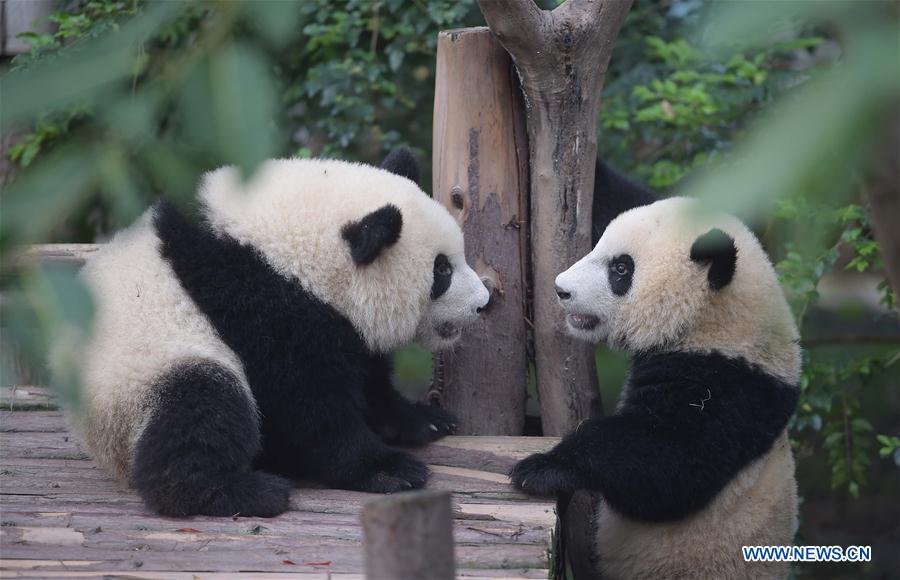
Photo taken on Sept. 7, 2016 shows two giant pandas in Chengdu Research Base of Giant Panda Breeding in Chengdu, southwest China's Sichuan Province. A Chinese giant panda expert said on Tuesday that it is too early to downgrade the conservation status of the species after the International Union for Conservation of Nature (IUCN) took the species off its endangered list on Sunday. The IUCN said in a report that the panda is now classified as "vulnerable" instead of "endangered," reflecting growing numbers in the wild in southern China. The union attributed the increase in population to decades of dedicated conservation efforts in China. (Xinhua/Xue Yubin)
CHENGDU, Sept. 6 (Xinhua) -- A Chinese giant panda expert said on Tuesday that it is too early to downgrade the conservation status of the species after the International Union for Conservation of Nature (IUCN) took the species off its endangered list on Sunday.
The IUCN said in a report that the panda is now classified as "vulnerable" instead of "endangered," reflecting growing numbers in the wild in southern China. The union attributed the increase in population to decades of dedicated conservation efforts in China.
Zhang Hemin of the China Conservation and Research Center for the Giant Panda (CCRCGP), widely known in conservation circles as the "father of panda," told Xinhua he felt it was still too early to downgrade their status.
"A severely fragmented natural habitat still threatens the lives of pandas; genetic transfer between different populations will improve, but is still not satisfactory; climate change is widely expected to have an adverse effect on the bamboo forests which provide both their food and their home; and there is still a lot to be done in both protection and management terms," Zhang said.
The wild giant panda population is broken up into 33 isolated groups, some with fewer than 10 individuals, severely limiting the gene pool. Of the 18 sub-populations consisting of fewer than 10 pandas, all face a high risk of collapse, according to Zhang.
Since 2010, the CCRCGP has focused on improving the captive breeding of giant pandas and on preparations for releasing captive-bred animals into the wild. According to Zhang, only when the wild population maintains steady growth without the addition of captive-bred individuals should the species be redefined as less endangered.
Zhang said the pre-release training of captive-bred pandas had improved substantially, helping them adapt to life back in their natural environment. In this way, the population has increased and their reproductive success is assured.
"If the conservation status is downgraded, protection work might slacken off and both the panda population and their habitat are more likely to suffer irreversible loss," Zhang said. "The present protection achievements will be lost and some small sub-populations may die out."
Disease also poses a threat. Canine distemper virus (CDV) affects a wide variety of animals including domestic dogs, primates and large cats. CDV caused the deaths of two pandas in northwest China's Shaanxi Province around the end of 2014.
"There is no specific remedy or vaccine for the disease," Zhang said. "Epidemic and disease containment work is vital for panda protection."
The IUCN listing as "vulnerable" instead of "endangered" did not mean that pandas no longer need continuous protection, said Shi Xiaogang of Wolong National Nature Reserve.
Shi said it was a cause for celebration that China's protection efforts had been recognized, "but as conservators, we know that the situation of the wild panda is still very risky."
Having worked with pandas for over 20 years, Shi and his colleagues mainly monitor wild pandas' activities, their health and reproductive status. Shi said he knows of innumerable practical problems in the protection of wild pandas. Human activities such as tourism and herb gathering can severely affect the wild pandas' habitat, he said.
No matter what the conservation status is, we will not change our attitude toward protecting these animals, he said.
At the last count, at the end of 2015, China had 1,864 giant pandas in the wild, up from about 1,100 in 2000. There are also 422 animals in captivity, according to China's State Forestry Administration.











